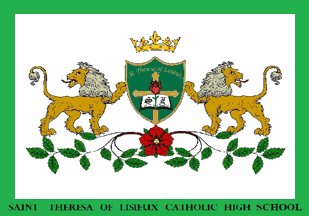
image contributed by Garry M. Borgacci, 24 April 2008

Last modified: 2012-08-09 by rob raeside
Keywords: canada | saint theresa of lisieux catholic high school |
Links: FOTW homepage |
search |
disclaimer and copyright |
write us |
mirrors

image contributed by Garry M. Borgacci, 24 April 2008
See also:
External links:
Saint Theresa of Lisieux Catholic High School has its new school flag.
And the story about the flag:
What's in a Flag? … You say …
Well a flag represents an idea, an ideal, a group or nation. It is not just a decoration, nor an object to be honoured by itself. It is honoured for what it represents to that group, nation or institution. Many flags are held in high admiration for their history; for the sacrifices made by the people; for the qualities for which the country and people represent. The study of flags is called Vexillology, which rules, the design, the creation, the symbolisms, and principles, while ensuring a continuous research and study of the standard.
The word "vexillology" is a synthesis of the Latin word vexillum and the suffix –"ology" meaning, "study of." The vexillum was a particular type of flag used by Roman legions during the classical era. The respect to the flag does not depend on the visual appeal of the design, or on it attempting to symbolize visually the people, politics or faith of a country or group. If it represents anything material, a flag generally symbolises the unchanging characteristics of a group or country. These may include the geographical setting, or possibly a characteristic physical feature, historical basis, or the constitutional configuration.
The origin of flags lies in ancient history. The Roman used a form of flag, the Standard, an image such as a statuette on a pole or a staff, which was at times difficult to carry and cumbersome… thus came the cloth version, which was most likely imported into your Europe by the Romans from the far east, China and India. Originally they may have been merely decorative streamers, or possibly ceremonial images. They were superior to many other emblems: cheap and simple to make; easy to carry and display; and attracting attention with their lifelike ability to move in the wind.
With this, flags came to symbolise variously leaders, communities, gods, merchants and craft guilds, ships, towns, institutions and families. Flags in time gained the same respect as was accorded to the person or thing, which it represented. Flags often bore religious symbols, and were used in religious as well as state occasions. The flag of Saint Theresa of Lisieux was created with this in mind, to represent our faith, our institution (school) and what we, as a Catholic learning community symbolize. When creating the Flag, I wanted to show these aspects, a learning community, engaged, while ensuring our faith and hopes were represented. The "Little ways" that Saint Theresa of Lisieux constantly persisted, as did this community, in achieving its High School, an intently and beacon of Christian faith in Richmond Hill.
The Saint Theresa of Lisieux Catholic High School flag's image can be explained as follows:
The crown above the crest is the crown of Christ, King of Kings, with a cross to remind us of His sacrifice for us, and our service to Him, and to encourage us to follow the ways of the Cross. The colour of the crown is gold; both in Heraldry (Study of Crest and Coat of Arms) and Vexillology, the colour gold represents generosity and elevation of the mind.
The Rose is the little rose that Saint Theresa of Lisieux gave us, the little ways of doing ordinary things with extraordinary love, the roses from heaven. The colour red represents strength and magnanimity and sacrifices. The rose, which is below the school crest and is supported by rose petals and stem, indicates the continuous flower and ongoing blessing from above, and the knowledge it provides. The school crest is held by two distinguished golden lions, which are there to protect and defend; they are positioned on the leaves of the rose, identifying the unity of our Catholic school family. The lions further symbolize bravery, valour, strength and courage, all aspects that were portrayed by our patron saint during her life. Lions, in heraldry, also symbolize royalty, God in His royal majesty, creator of heaven and earth.
The body of the flag is white to indicate purity, peace and sincerity, aspects of our Christian ways, framed in the colour green representing hope, joy, and loyalty in love. The colour green also represents the Town of Richmond (Town Colour), location of our high school.
Garry M. Borgacci, 24 April 2008